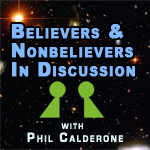I have a better internal and intuitive understanding of folklore and myth than science and technology, so in that way fantasy is easier.
-Sarah Zettel, novelist
Josh Peck is a self-described biblical researcher, author and online show host. He has written several books, including “Quantum Creation,” a book about prophecy and “quantum physics from a Christian perspective.” You may be thinking that there is no such thing as “quantum physics from a Christian perspective,” but Mr. Peck tells us otherwise. He explains there is nothing wrong with the experimental results of science, just the interpretation by those who do not cross-reference the holy book. He claims no conflict between science and religion because:
“When we have the proper interpretation of scripture and the proper interpretation of scientific observation, they should both agree in full. They both should act as two pillars holding up the true understanding of reality. If they do not agree then one or both of the pillars are broken and must be fixed, otherwise the whole structure will come crashing down.”
In other words, scientific observation and scripture have the same level of legitimacy and since scripture is correct because, you know…word of deity…any scientific finding that conflicts with scripture must be reinterpreted until it matches. There now, no conflict.
It is hard to swallow that this bastardization of sound methodology is what many believers call science. It is not, though this is what is being taught to the faithful uncomfortable with scientific findings that imply their deity is not the creator of the universe. Their thinking is rationalization (conscious and unconscious) biased by a presupposition of biblical inerrancy. The cognitive blindness is stunning, truthiness applied like a taste preference.
Interestingly, this type of science-off-the-rails often does include some true science. It may even include a great deal as some of Jason Lisle’s early work demonstrates. (Dr. Lisle is a properly educated physicist who left his career when it didn’t conform to his religious beliefs, in particular that of a 6000 year old universe.) However where Dr. Lisle goes off track can be hard to decipher if one does not already have strong science knowledge, an inherent problem. If one has been raised with a religiously dominated education where evolution, geology and psychology have been replaced with creation myth, a flood story and objective moral rules, it is nearly impossible to notice the slips. To a student listening to this mangled science such presentations can appear to reinforce scriptural texts. Passages are “matched” through numerology-like pattern recognition, subjective interpretation and prophesy-alignment presented as evidence.
Real science does not operate in this manner. It works on a much tougher playing field where objective evidence rules. Results only sufficient for subjective interpretation are used as guideposts for further investigation (and replication by other studies); they are not touted as final conclusions to be taught to the public. (Note: despite this standard practice scientists are human and can overstep at times, but the fields are aware of this, constantly open to internal criticism and correction. For good coverage on this, check out Robert Burton’s “A Skeptic’s Guide to the Mind: What Neuroscience Can and Cannot Tell Us About Ourselves.”
The vast majority of scientists follow evidence where it leads them. Often this disagrees with chunks of what religiously-filtered “science” teaches. A young believer can find themselves stuck trying to understand these different positions, akin to being asked to take sides in a parental dispute. Worse, parents and preachers may fight back with accusations of academic conspiracy and ivory tower arrogance. If a student buys this defense they not only learn bad science, they learn to mistrust true experts and even the scientific method.
If a student is able to remain objective she will find the position conflicts unresolvable; where there is disagreement, one side is right and one side is wrong. Contrasting this, a true believer (defined as one unwilling or unable to de-sanctify false beliefs) will learn to swim in a fog of cognitive dissonance, motivated reasoning tools at the ready, perhaps for the rest of her life.
Another feature in hesitation to accept scientists conclusions can lie in the personality trait of mistrust. You know the accusations—scientists are money mongers who deliver results their patrons desire, universities are places where snobby faculty pretend they are smarter than the rest of us, arrogant intellectuals create fancy jargon so they can talk over our heads. Tables are turned with true scientists being branded as pseudoscientists.
The believer’s solution to this supposed deception? A call to individual critical thinking (paradoxically), self-evaluation of experimental results. In other words a belief that a single person, believent and less educated, is more likely to make a better conclusion than a highly educated specialist.
This is purely wrong. First, anyone with less information is by definition less capable of making a better judgement than one with more information, though admittedly we must be wary of researcher confirmation bias. Second, this type of self-confident believer puts more weight on intuition (Type One thinking) than is valid. (See Daniel Kahneman’s “Thinking Fast and Slow.”) Third, individual conclusion, be it by a highly educated researcher or an individual, is prone to error—exactly why scientific conclusion relies on expert consensus, not expert opinion. Further yet, scientific consensus is subject to longitudinal review—study over time—subject to future refinement or replacement.
Meanwhile unscientific believers apply the tools of intuition, apologetics, argument and reinterpretation to scientific findings, mushing results into scripturally-shaped conclusions of their satisfaction. Have you ever watched a numerologist finding patterns everywhere they look? It really is amazing, the mental gymnastics humans are capable of.
Argument is not evidence, nor philosophy experimentation. Bias avoidance does not include presupposition; it starts with a null position. And “not considering deity” is not a presupposition; it is an appropriate “we don’t know” starting position.
Sadly, expect religious scientism to continue because it appears to relieve believers of some of their dissonance. Many of their conclusions will be wrong of course but lay believers may not recognize this.
Spins your head, doesn’t it? Keep this in mind the next time you consider popping a chad for a candidate who denies climate change, supports funding educational vouchers, or advocates shutting down the Department of Education. Meanwhile teach your children well. Give them science toys as gifts. Challenge their minds. Foster curiosity, wonder and intellectual interest. There is a big real world to learn about and it is much more accessible if they do not have to first dig themselves out of a false information hole.



